MARIANI’SVirtual
Gourmet
December 16,
2012
NEWSLETTER

REMEMBER THE NEEDIEST DURING THE HOLIDAYS
❖❖❖
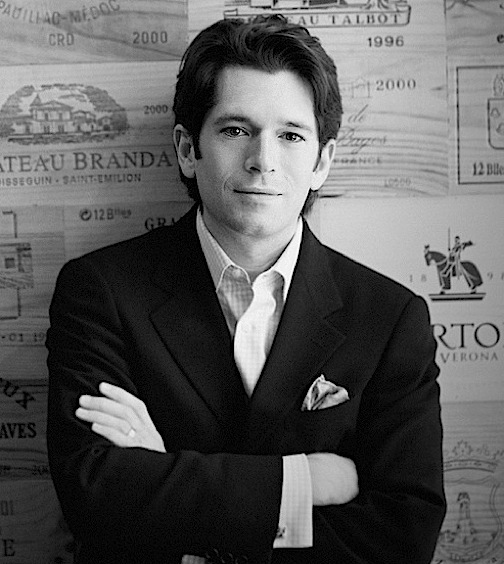
ANNOUNCEMENT: The Virtual Gourmet's own contributing editor Brian Freedman
now hosts “Hungry In...Philadelphia” online at the Hungry Channel. The show,
powered by Citysearch, takes viewers on virtual food tours of cities across the country.
This week, it’s meat and cheese in Philly--but no cheese steaks!
Watch it at citysearch.com/hungryin <http://citysearch.com/hungryin>
❖❖❖
by John Mariani
NEW YORK CORNER
Jean-Louis
by
John Mariani
NOTES FROM
THE WINE CELLAR
Burgundy’s 2012
Vintage: Small Crop,
Promising Quality, Soaring Prices, All Smiles
by John Mariani
❖❖❖
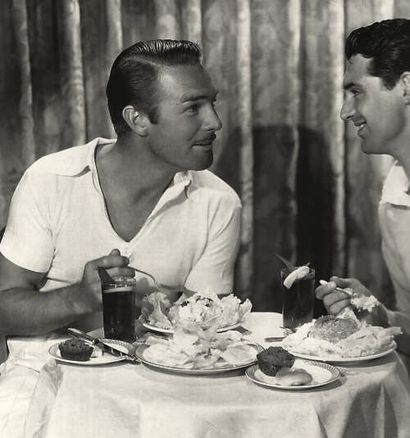
Randolph Scott and Cary Grant
Part Two
by John Mariani
picca
cantina
5575 West Pico Boulevard
310-277-0133
www.piccaperu.com
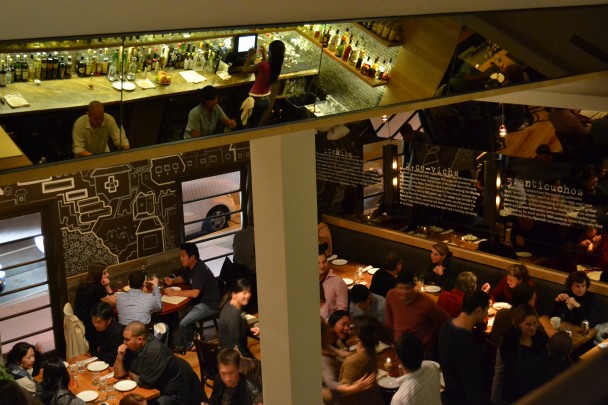
"Picca," notes the menu, means
"to nibble," and that's the
plan behind this very popular small plates
restaurant of 50+ modern
Peruvian-Japanese dishes by Chef Riccardo Zarate (below), who also owns two, smaller
Mo-Chica eateries that serve
similar food.
The evening I ate at Picca, there
were three of us, so, try as
we did do dent the menu, we were only able to try
only a baker's dozen of dishes,
starting with tuna tartare with avocado, lemon soy,
sesame oil, and wonton
chips. The papa
rellena was a stuffed potato (the white
potato originated
in Peru, by the way), with braised beef, boiled egg,
and walnut pesto, a wonderfully sloppy dish 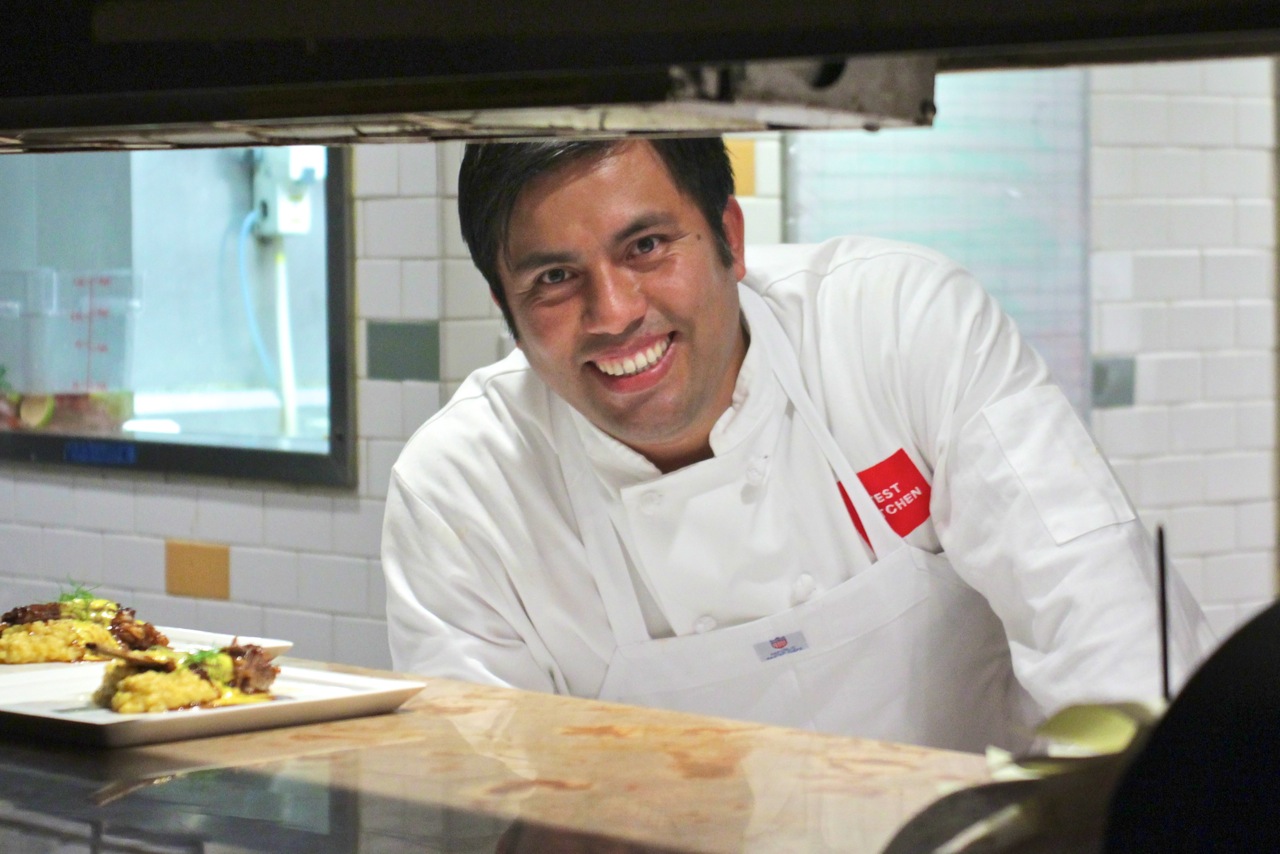 to savor with a smile on
your face. Just as sumptuous in its simple
way was patita,
a pig's trotter stew with chorizo, potato, aji pancam,
and the
crunch of peanuts. Causa (sushi) shrimp came with a yuzu guacamole,
salsa
criolla, and cucumber, while seco de pato
was a confit of duck's leg in a
rich Peruvian beer sauce with aromatic cilantro
rice. Also highly
recommended to the carapulcra of roasted black cod,
sun-dried potato stew,
peanuts, and chimichurri.
to savor with a smile on
your face. Just as sumptuous in its simple
way was patita,
a pig's trotter stew with chorizo, potato, aji pancam,
and the
crunch of peanuts. Causa (sushi) shrimp came with a yuzu guacamole,
salsa
criolla, and cucumber, while seco de pato
was a confit of duck's leg in a
rich Peruvian beer sauce with aromatic cilantro
rice. Also highly
recommended to the carapulcra of roasted black cod,
sun-dried potato stew,
peanuts, and chimichurri.
There was lots more and next time
I'll go with a passel of friends
and plough through everything, for everything sounds
equally appealing on a
menu where some items go for five bucks and none for
more than $17. The wines, all from South America and
Iberia, are very gently priced.
The place itself, on two spacious
levels, is built for fun and quick
turnover, and things get intensely loud throughout,
even at our cozy corner
table, which was somewhat shielded from the noise.
It's also a neighborhood place, right
near the 20th Century Fox lot, and most of the
people around us were locals who
said they never ventured downtown to eat. I
can understand why. It
could take weeks to eat everything on the menu here,
then come back for
favorites.
Picca is open nightly.
Ink
8360 Melrose Avenue
323-651-5866
mvink.com
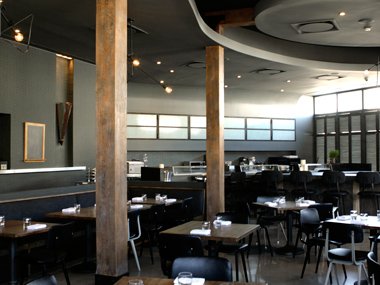 First
thing you have to know is
that, if you think Picca is loud, you'll find
Ink is very, very loud.
In fact, when I inquired of the manager if the
pounding, piped-in music might be turned down a
tad, he said (actually shouting to be heard), "Chef
says, if he can't hear his playlist in the
kitchen, it's not loud enough." So much for
caring for customers' creature
comforts.
First
thing you have to know is
that, if you think Picca is loud, you'll find
Ink is very, very loud.
In fact, when I inquired of the manager if the
pounding, piped-in music might be turned down a
tad, he said (actually shouting to be heard), "Chef
says, if he can't hear his playlist in the
kitchen, it's not loud enough." So much for
caring for customers' creature
comforts.
There really isn't much to say
about the décor,
which looks unfinished--gray walls, gray concrete
floor, raw wood pillars, bare
tables, all hard surfaces adding to the noise.
This is another small
plates place, though here the plates start at $9 and
go up to $26, with a
tasting menu of the night's specials of four dishes
at $85, a tab that puts
Ink in a price category with far more posh and
consumer-friendly restaurants in
L.A. Consider that the 7-course tasting menu at the
elegant Valentino in Santa
Monica is the same $85, an omekase meal at Matsuhisa is $90,
and you could easily dine sumptuously for that
amount at Spago in
Beverly Hills. 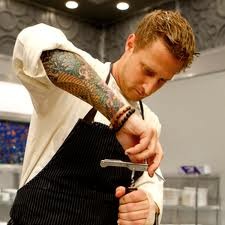
Chef Michael Voltaggio (right), with
long experience at top American
kitchens, including Bazaar in L.A., is best known
for winning the prize on TV's
"Top Chef." At Ink, he calls his cooking "modern los
angeles
cuisine" intended to "re-purpose the term `fine
dining.'"
I can't quite see how this has been accomplished,
for while there are many
tasty dishes at Ink, including shishito
peppers with almond-bonito
"sand," tofu and mustard; an excellent crispy
softshell crab with
tarragon mayo, capers, and tomato; and deliciously
decadent pork belly with "charcoal
oil," "bbq flavor" and corn, there are other
dishes that just
fall flat, like his already rich, cream-filled burrata cheese
complicated with an oozing egg yolk,
lettuce, and lemon dressing; his halibut with
cold "embers' of zucchini
and potato with sesame, mayo, and black vinegar is
pretty weird. Most dishes fell in
between highly appealing and out of the ordinary in
a less than savory way, like
his "burnt wood ice cream." which tasted, well, like
smoky ice cream, not a flavor likely to make it onto
Ben & Jerry's roster.
Had
Voltaggio done no more than Picca in the
small-plates leagues, Ink might be
far more lovable. But where Picca’s food seems a
mélange of scintillating, natural flavors,
Ink’s
often seems strange, and at a much higher price,
none of which constitutes a
re-purposing of fine dining.”
Ink is open nightly for dinner.
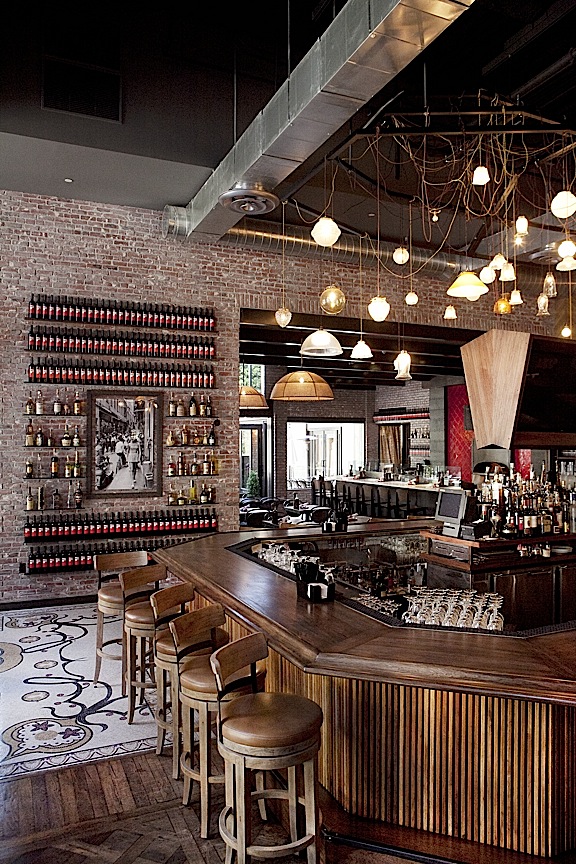 Soleto Trattoria &
Pizza Bar
Soleto Trattoria &
Pizza Bar
801 South Figueroa Street
213-622-3255
www.innovativedining.com/restaurants/soleto
Things have been getting more
gastronomically interesting in downtown L.A., with the
opening in recent
years of John Sedlar’s Rivera and Wolfgang Puck’s
WP24. Soleto
Trattoria & Pizza Bar, if
not unique, is a welcome new Italian place in the
Financial District with
a really handsome, 1,100 square foot patio outdoors. Inside there is a huge,
360-degree hickory bar and brick-walled
lounge that gets a midday and after-six crowd.
Soleto
is the newest of the Innovative Dining Group’s
restaurants, which operate Boa
Steakhouse, Sushi Roku, and other spots around
town. Executive Chef Sascha Lyon oversees
Soleto’s
menu, which features good, crisp, well-topped pizzas,
panini, a
burger (of
course), and bar food type items throughout. One of
the pizzas, with fig,
prosciutto, mozzarella, arugula, and Gorgonzola dolce is a bit
too much of a
good thing, but it is
indeed a good thing.
But
I’ll go for the generous Italian dishes, none
innovative but just about all well
rendered, from a good crispy mozzarella marinara in
casserole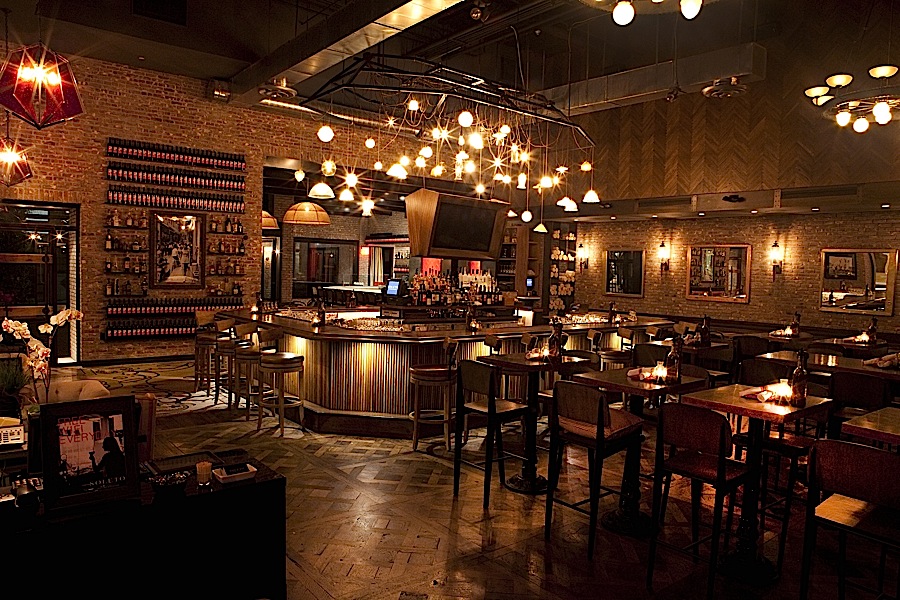 with a basil
pesto to impeccably fried calamari with grilled lemon and two
sauces.
with a basil
pesto to impeccably fried calamari with grilled lemon and two
sauces.
You
won't find better pumpkin ravioli, with mushrooms and
hazelnut sage, in town
than Soleto’s, and his al dente rigatoni with a rich ragù and
sweet sausage and
escarole is a winner, too. Orrechiette diavolo with spicy
sausage, rapini,
and
chile flakes didn't meld very well.
My
favorite among the entrees was a branzino milanese,
with arugula,
lemon, and grana
padana, a recipe that proves fish, with a
crust, can take to grated
cheese well. A
herb-roasted half
chicken with Yukon potatoes was just fine, if hardly
out of the ordinary when roast chickens are
everywhere.
For
dessert go with the chocolate budino pudding,
creamy and cool to savor as you sit in
the L.A. sun, sipping a cup of espresso.
The
wine list is suffused with overly familiar name brands
like Santa Margherita and
Jordan. It
should be better, but
there are plenty of bottlings under $40, which makes good sense.
Soleto
serves its purpose well, which is to delight
downtowners, those who work there, and those about to
head home. Chef
Lyon is making
sure that the Italian food he produces is in the right
groove for the
neighborhood, and the place took off fast because it
seemed so well poised to do so.
Soleto is open Mon.-Fri. from 11 a.m.-11
p.m., Sat. & Sun. 5-11 p.m.
Bel-Air Hotel
701 Stone Canyon Road
310-909-1644
wolfgangpuck.com
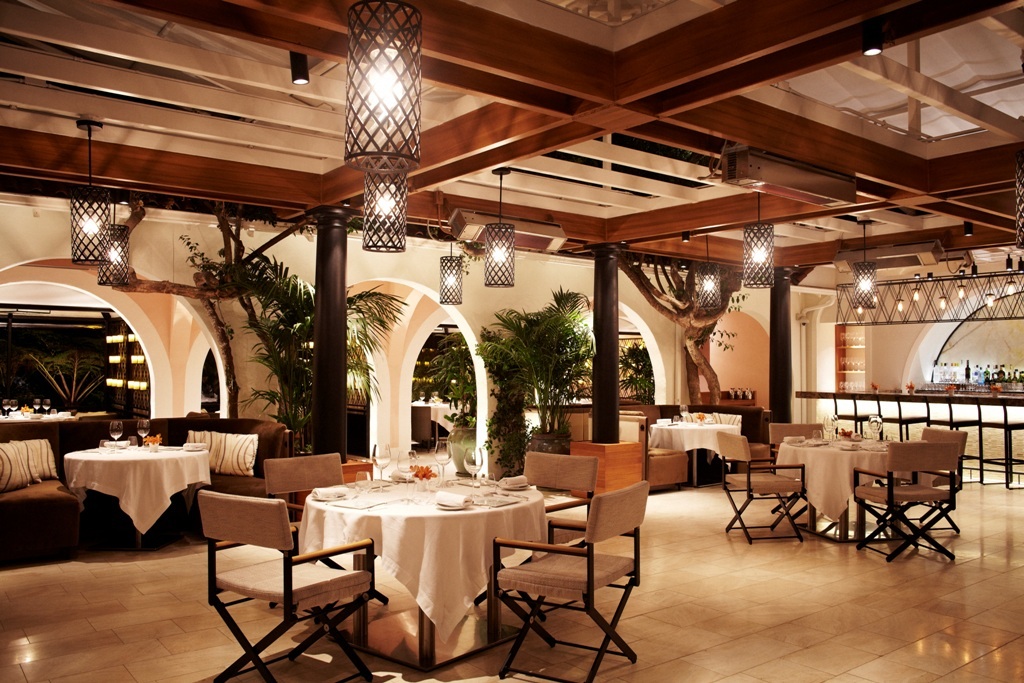 The
two-year, $100 million dollar renovation of the
Bel-Air Hotel has succeeded very admirably in turning
a once alluring dowager into a young white swan--think
of Ava Gardner transformed into Scarlett Johanssen. In
fact swans swim in meandering streams surrounded
by dense foliage.
The
two-year, $100 million dollar renovation of the
Bel-Air Hotel has succeeded very admirably in turning
a once alluring dowager into a young white swan--think
of Ava Gardner transformed into Scarlett Johanssen. In
fact swans swim in meandering streams surrounded
by dense foliage.
The Hotel, now part of The
Dorchester group, had acquired that patina of
age whereby it was beginning to look dowdy, and now it
has become one of the most romantic and beautiful
designs among California hostelries, with light
colors, wall finishes you hardly notice till you touch
them, excellent use of modern furniture, sumptuous
fabrics, and reminders everywhere of the water and
seclusion that the hotel has always provided, hidden
as it is up the winding Stone Canyon Road, which
might even defy a GPS. (Its location keeps out the
idle curiosity seekers.) Always glamorous, the hotel
now has a shiny new posh for a younger crowd.
The outdoor patio dining area
(left) has
always been as iconic to L.A. dining as the Polo
Lounge at the Beverly Hills Hotel, and now, the
interior restaurant has been reclaimed as a swank bar
and lounge (right),
enticing on its own. Into these spaces, the
owners have brought a name brand--Wolfgang Puck, whose
track record in fine dining begins with Spago in
Beverly Hills but has not of late been among his
company's empire-building of more casual
concepts. So, everyone was waiting to see what
Puck could produce that would wow the fine dining
crowd without copying Spago, itself just recently
renovated into something quite different from what it
once looked like.
The Bel-Air's exterior space is as
winsome as ever, with director's chairs and
overstuffed banquettes ladies sink into at
lunch. I can't say I'm crazy about those huge
torchlight heaters that dot the place. If it's too
cold to dine out, why not go inside? By the way, the
floors are also heated outside.
I'm crazy about those huge
torchlight heaters that dot the place. If it's too
cold to dine out, why not go inside? By the way, the
floors are also heated outside.
The menu plays it
pretty safe--Puck and his partner Lee Hefter also run
the breakfast and functions of the hotel--and there is
a $39 "60 Minute Power Lunch" available.
Everything, including the
irresistible pretzels, are made on the premises.
There are flights of rich man's fantasy here, like the
osetra caviar with crème fraîche "snow."
I dined there early on when it
opened, and I thought the menu needed some snap, but I
could not have enjoyed more the tortelloni with
spring peas that truly tasted as if just plucked from
a garden. Fromage
de tête showed Puck's enduring
affection for French home cooking, sweetbreads were
full of flavor, plump Dover sole was impeccably
cooked, and the red snapper crudo was a success, tangy with
blood orange and shaved fennel with a touch of avocado
for sweetness. Goat's cheese-encrusted saddle of lamb
was of excellent quality and cooked to a rosy turn to
retain all the juices.
Again, it was early on, so the
service staff that evening was lax, cocktails and
wines took forever to bring to the table, and the
winelist itself is in the stratosphere with its
prices.
If invited by some Hollywood
poobah, I'd certainly return, if only to bask in that
quiet pastoral that makes the Bel-Air unique. I
trust, too, that the food may be more enticing and the
service staff up to snuff.
Open for
breakfast daily; lunch Mon.-Sat., Sunday brunch;
dinner nightly, Dinner appetizers, $15 to $26; main
courses, $28 to $55; four-course tasting menu, $110;
six courses, $145.
❖❖❖
NEW YORK
[SUBURBAN] CORNER
by John Mariani
JEAN-LOUIS
61
Lewis Street
Greenwich, CT
203-622-8450
www.restaurantjeanlouis.com
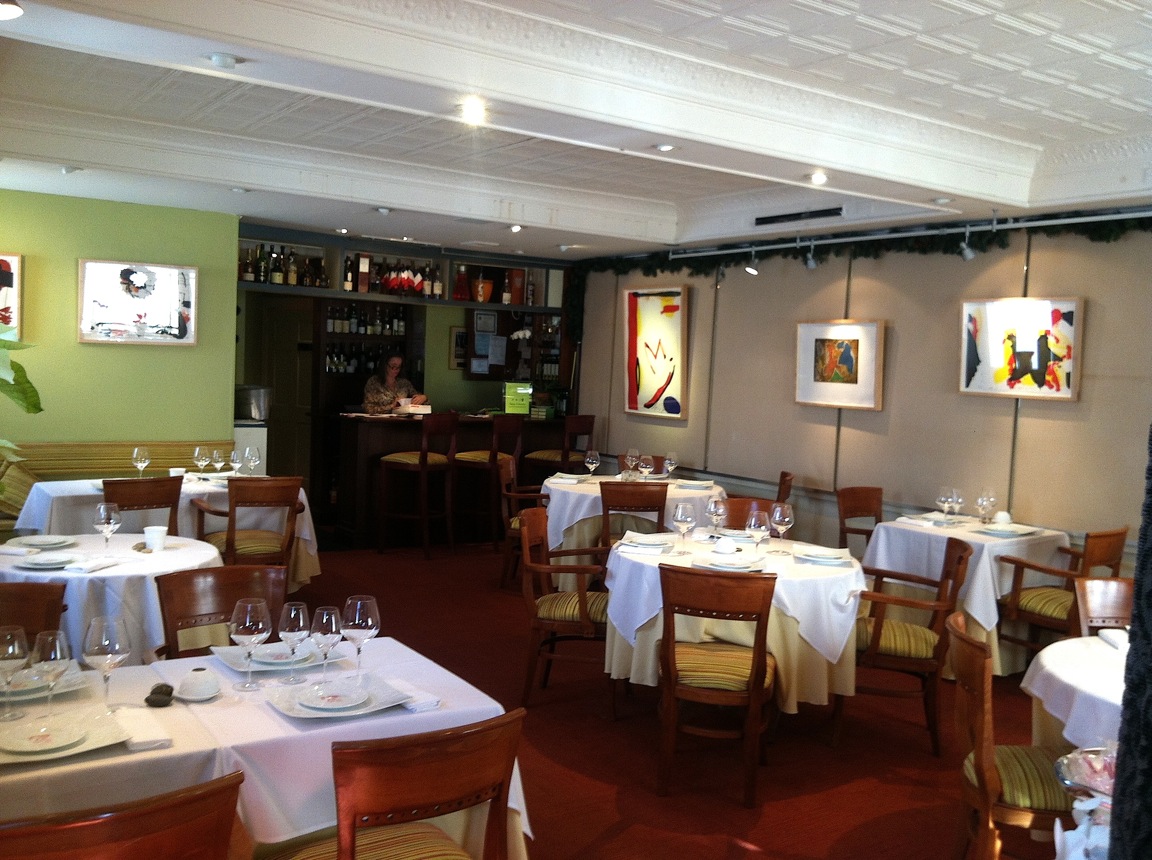 If you have
never dined at Jean-Louis in Greenwich, CT, there’s
little time left to do
it. After
December 22nd,
Jean-Louis and Linda Gérin will close the doors
to their little jewel box
restaurant that has for three decades been one of the
finest in the region.
If you have
never dined at Jean-Louis in Greenwich, CT, there’s
little time left to do
it. After
December 22nd,
Jean-Louis and Linda Gérin will close the doors
to their little jewel box
restaurant that has for three decades been one of the
finest in the region.
My reason for
writing about it at all, then, is as a paean to the
Gérins for so many years of
superb cuisine and service as well as to say something
about the state of such French
restaurants as this one, tucked away in the
increasingly frenetic dining scene of
Greenwich. To
paraphrase the
ending of “Death of a Salesman,” “Attention must be
paid to such a chef.”
The short
history of the award-winning Jean-Louis is that he
came to Greenwich as a young chef under
Michelin-starred master Guy Savoy back in 1983, who a
year or so later sold the
restaurant to the Gérins. Over the years,
Gérin showcased his mentor’s nouvelle
cuisine style but eventually made the kitchen
his own, and, over that long
period of evolution, changed his own style, which
ranged from classic French cooking
to a fusion of French and American dishes. There was even a period when he
decided to cut out much of
the fat from his cooking, but that fortunately didn't
last long.
Back in the
1980s the NYC suburbs had a number of excellent,
serious French restaurants, a
couple of which—La Crémaillière in
Banksville, NY, and La Panetière in Rye,
NY—are still around, joined, since Jean-Louis opened,
by several others,
including Thomas Henkelmann at The Homestead Inn and
L’Éscale in Greenwich. All these
are much larger
restaurants, while the Gérins never expanded
their dining room, which even
today has only 50
seats, most
filled with regulars who have come here for more than
one generation.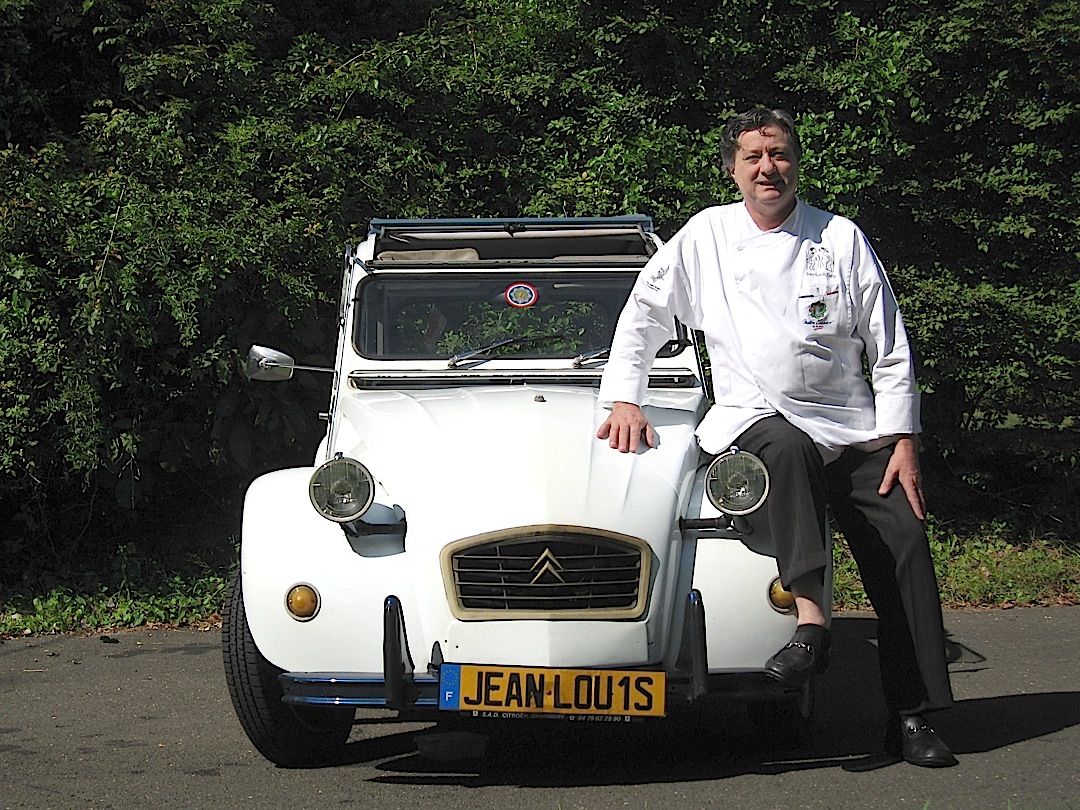
It is a dining
room where most men wear jackets and the women dress
up in the name brand
fashions now sold in the pricey boutiques along
Greenwich Avenue.
The lighting is perfect, the noise
level civilized. Linda
always
greets guests and Jean-Louis comes into the dining
room several time during the
night, knowing most everyone in the room. The wine
list is one of the finest in
the region, and Jean-Louis’ kitchen has been a
graduate school for young chefs
over the years.
The current
menu reprises the “Best of 30 Years,” both in a dégustation
of 7 courses
($79) or as a 3-course “Anniversary Ballade Gourmande”
($69). My wife and I
had the “Best” menu, beginning with an endive salad
with caviars, then a
terrine of foie gras with salad, fruit and nuts. The
fish course was scallops
seared on a cast-iron skillet, served with truffled
risotto and a poultry jus,
followed by Vermont quail with dried fruits and celery
puree. The
main course of game was a medallion
of venison with a classic, wine-rich Grand Veneur
sauce. For dessert, four different
sweets were presented, along
with petit-fours and chocolates.
It was the kind
of well-paced meal I had come to expect of Jean-Louis,
rich without being
filling, impeccably served on fine signature china and
thick, soft linens. Clearly it was a night tinged
with a certain degree of
sadness and nostalgia but with no regrets. We enjoyed
every minute being there, even when saying goodbye to
the Gérins.
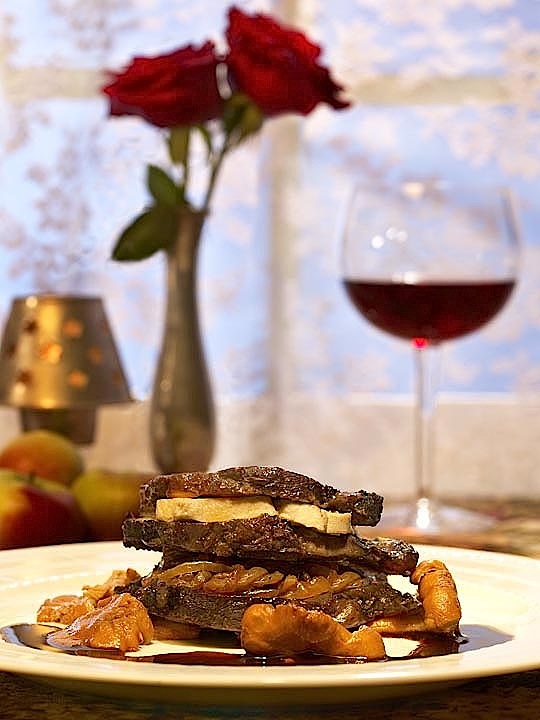 So why is
Jean-Louis closing, especially since the restaurant
and his ancillary catering
business has been doing very well?
It’s the same old story, which is not about the
so-called "death" of
French cuisine.
It’s about the
cold, hard rent, which the Gérins’ landlord has
multiplied to a number no restaurant could
possibly meet. By
the same token,
Jean-Louis has been asked to join the New England
Culinary Institute, which
will take him for most of the week to Montpelier,
Vermont, where he will direct
and teach, something he has long wanted to do. Meanwhile, he will keep his
Greenwich residence.
So why is
Jean-Louis closing, especially since the restaurant
and his ancillary catering
business has been doing very well?
It’s the same old story, which is not about the
so-called "death" of
French cuisine.
It’s about the
cold, hard rent, which the Gérins’ landlord has
multiplied to a number no restaurant could
possibly meet. By
the same token,
Jean-Louis has been asked to join the New England
Culinary Institute, which
will take him for most of the week to Montpelier,
Vermont, where he will direct
and teach, something he has long wanted to do. Meanwhile, he will keep his
Greenwich residence.
So this is not
a mournful story of how yet another French restaurant
was driven out of business for lack of
it. What
it does show is how difficult
it is for any small mom-and-pop venture to thrive in
the face of rising real
estate. Who
knows, maybe the
landlord can rent it out to a Lenscrafters or Verizon
store. If
true, that is clearly Connecticut’s
loss.
Had Jean-Louis
been an Italian or American or Asian restaurant, the
story would have turned
out the same. So
I do not lament
the closing of a French
restaurant; I lament the closing of an era when two
very committed people can do such a wonderful thing
for so long in such a small
personalized way.
It is not encouraging for the
future of dining out in America to
see pl,aces like Jean-Louis disappear.
Still, if
Jean-Louis the Restaurant is gone, long live
Jean-Louis the Educator! He has much to teach more young
cooks
about the right way to do things and why cuisine is
more than a flash in the
pan as shown in TV.
Jean-Louis will
serve dinner until Dec. 22 when he holds a last night
farewell party for
invited guests only.
❖❖❖
NOTES FROM THE WINE CELLAR
Burgundy’s 2012 Vintage: Small Crop,
Promising Quality, Soaring Prices, All Smiles
by John Mariani
 Despite
losses of up to 40 percent of their crop for the
2012 harvest, the vintners and merchants of Burgundy
are smiling and doing a bit of winking, too.
Despite
losses of up to 40 percent of their crop for the
2012 harvest, the vintners and merchants of Burgundy
are smiling and doing a bit of winking, too.
In Burgundy, whose wines compose only about 3
percent of France’s total production, the wineries
sell just about every drop they make, even in abundant
years. But they haven’t had an abundant year since
2009: in 2010 quantity was down 40 percent, in 2011 it
was 15 percent.
This year winter’s frost combined with mildew
and hail later on destroyed more than half the crop in
prestigious vineyards like Château de Pommard.
At the charity wine auction at the Hospices de
Beaune (left)
held each November in the city of Beaune, which has
taken place since 1851 and, since 2005, been organized
by Christie’s, Burgundy officials, vignerons, and
negoçiants spoke of the situation with a
curious mix of regret and bonhomie. “The damage of up
to 50 percent in the Côte de Beaune was a
disaster!” moaned Michel Baldassini, President
Délegé and Acting Chairman of the Bureau
Interprofessionnel des Vins de Bourgogne (BIVB), but
then brightened with the announcement that “the
highlight in 2012, however, is that the reds have
fantastic concentration with silky, powerful tannins.”
Pierre-Henry Gagey, President and
Chairman of the BIVB, was positively buoyant, saying,
“Prices are always a question of supply and demand,
and Burgundy is selling very well these days. Prices
will definitely be higher for the 2012s, but if we get
a big harvest in 2013, it may dampen the consumers’
shock.”
Louis-Fabrice Latour, President and
Chairman of the Federation des
Négociants-Éleveurs de Grande Bourgogne,
 added to the
high spirits by noting that “Burgundy has been
recession proof the last two years. The U.S.,
our biggest market, was up 10 percent for 2011, and is
our biggest priority right now because the dollar is
getting stronger. At the moment exports to Japan are
up 35 percent in value for 2011, and it soon could
surpass the UK as our second largest market, which
needs a re-boost.
Number four is Canada, then China, where all
the wine goes through Hong Kong.” Latour also
said higher prices were inevitable and warned, “There
just won't be any burgundies available at under $10 a
bottle.”
added to the
high spirits by noting that “Burgundy has been
recession proof the last two years. The U.S.,
our biggest market, was up 10 percent for 2011, and is
our biggest priority right now because the dollar is
getting stronger. At the moment exports to Japan are
up 35 percent in value for 2011, and it soon could
surpass the UK as our second largest market, which
needs a re-boost.
Number four is Canada, then China, where all
the wine goes through Hong Kong.” Latour also
said higher prices were inevitable and warned, “There
just won't be any burgundies available at under $10 a
bottle.”
Back at the wineries around Beaune,
I found a more guarded degree of optimism, since
farmers hate more than anything to lose crops,
especially three years in a row. “In the last twenty
years we have tried to educate’ the vines to grow less
grapes but of better quality,” said
Marie-Andrée Mugneret, who, with her sister
Marie-Christine, owns Domaine Georges Mugneret-Gibourg
(right) in
the Vosne-Romanée region. “Still, we weren’t
expecting to lose nearly half our production,”
pointing to two stacks of aging wine barrels, whereas
in a good year they would nearly touch the ceiling.
“Last year, we made 85 barrels; this year we have only
68.”
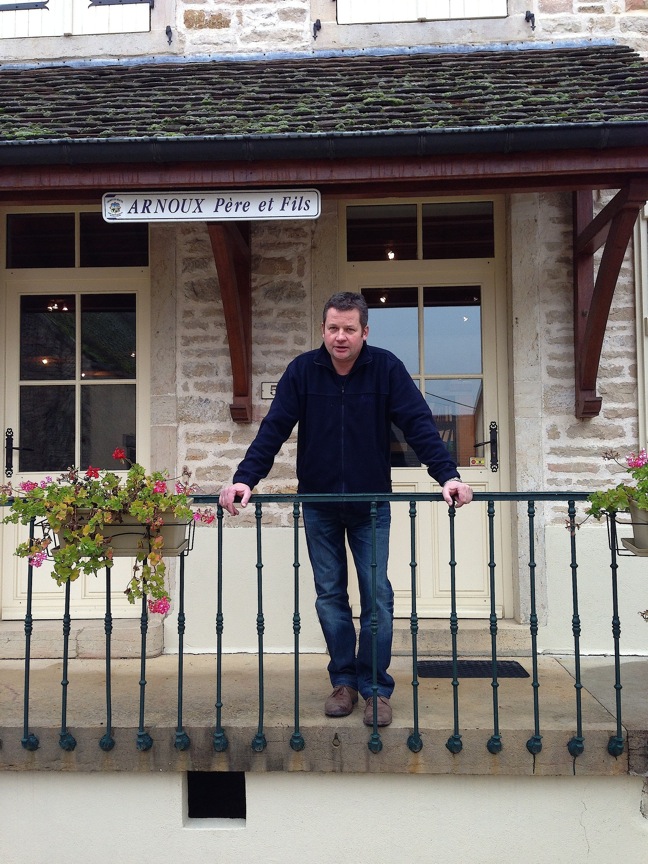 Mugneret
knows she can easily sell her wines for more money,
and the 2010s will begin appearing in the market next
year. “I
am relieved that the higher prices will help blunt the
lower supply,” she said, “but I’m skeptical that
Burgundy prices can just keep rising so much with
demand. We may price ourselves out of the market at
some point.”
Mugneret
knows she can easily sell her wines for more money,
and the 2010s will begin appearing in the market next
year. “I
am relieved that the higher prices will help blunt the
lower supply,” she said, “but I’m skeptical that
Burgundy prices can just keep rising so much with
demand. We may price ourselves out of the market at
some point.”
At Domaine Arnoux Père et
Fils in Chorey-les-Beaune, owner Pascal Arnoux (left) told me,
“The last good year for both volume and quality was
2009. That
was ideal and helped keep prices at a reasonable
level. This
year my volume is down 40 percent, but I think the
wines will turn out to be excellent.” He asked if I
wanted to be the first American journalist to taste
the wines out of the barrel, and I was fortunate to
sample most of the 15 wines Arnoux makes. I found the
Aloxe-Corton the most advanced—for a wine made from
grapes picked less than two months ago—and overall the
wines had lots of fruit and spice.
“I like my wines with lots of
fruit,” said Arnoux, "because we drink burgundy
younger now. Do I know, really, what these wines will
develop into? No, but I’m meeting this afternoon with
my colleagues to discuss the new vintage. I’m
optimistic about the quality.”
In any other luxury industry, the
impetus to increase holdings to increase sales is
basic business, but in Burgundy, where simply buying
more land, even the next acre over, does not guarantee
quality, and the pride of maintaining distinctive
excellence is the driving force. “My sister and I have
been asked many times if we are interested in buying
other lots to add to ours, which have been in our
family since 1933,” said Mugneret. “But I don't want
more and more land or money. Through good and bad
times, my quality of life has no price.”
John Mariani's wine column
appears in Bloomberg
Muse News, from which this story was adapted.
Bloomberg News covers Culture from art, books, and
theater to wine, travel, and food on a daily basis.
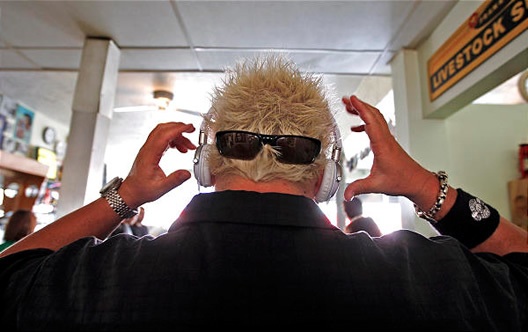 GEE, WE THOUGHT IT
WAS BECAUSE HE
GEE, WE THOUGHT IT
WAS BECAUSE HE
THOUGHT
PETE WELLS WAS GAINING ON HIM
TV
Food Guy Guy
Fieri
explained in an interview why he wears
sunglasses on the back of his head.
"It's
just a good place to hold them," says
Fieri. "You know how many times I've had them
around [the front] of my neck and they fall out?
And they
fall in the soup or something?"
BLOCK THAT METAPHOR!

"I'd been lusting
all day, and now here it was right in front of me,
next to a Lime Semifreddo (a lime mousse, covered
in Italian meringue and accompanied by some
molecular gastronomy tequila creation). Oh,
skip the lime, you may be thinking. Just go
straight to the chocolate, you're saying.
No, no my friends. You need both of
these. You need both of these beauties in
your life. The lime semifreddo is just as
beautiful on the inside as it is on the outside.
It's like key lime pie, gelato and souffle
had a baby. And the baby is sinful and
delicious."--Claire O'Bryan, "Here's What I
Thought About Stars Grill on King," Charleston Grit
(12/4/12).
❖❖❖
Any of John Mariani's
books below may be ordered from amazon.com.
 |
My latest book, which just won the prize for best book from International Gourmand, written with Jim Heimann and Steven Heller, Menu Design in America, 1850-1985 (Taschen Books), has just appeared, with nearly 1,000 beautiful, historic, hilarious, sometimes shocking menus dating back to before the Civil War and going through the Gilded Age, the Jazz Age, the Depression, the nightclub era of the 1930s and 1940s, the Space Age era, and the age when menus were a form of advertising in innovative explosions of color and modern design. The book is a chronicle of changing tastes and mores and says as much about America as about its food and drink.
“Luxuriating vicariously in the pleasures of this book. . . you can’t help but become hungry. . .for the food of course, but also for something more: the bygone days of our country’s splendidly rich and complex past. Epicureans of both good food and artful design will do well to make it their coffee table’s main course.”—Chip Kidd, Wall Street Journal.
“[The menus] reflect the amazing craftsmanship that many restaurants applied to their bills of fare, and suggest that today’s restaurateurs could learn a lot from their predecessors.”—Rebecca Marx, The Village Voice. |
"Eating Italian will never be the same after reading John Mariani's entertaining and savory gastronomical history of the cuisine of Italy and how it won over appetites worldwide. . . . This book is such a tasteful narrative that it will literally make you hungry for Italian food and arouse your appetite for gastronomical history."--Don Oldenburg, USA Today. "Italian
restaurants--some good, some glitzy--far
outnumber their French rivals. Many of
these establishments are zestfully described
in How Italian Food Conquered the World, an
entertaining and fact-filled chronicle by
food-and-wine correspondent John F.
Mariani."--Aram Bakshian Jr., Wall Street
Journal.
"Equal parts
history, sociology, gastronomy, and just
plain fun, How Italian Food Conquered the
World tells the captivating and delicious
story of the (let's face it) everybody's
favorite cuisine with clarity, verve and
more than one surprise."--Colman Andrews,
editorial director of The Daily
Meal.com. "A fantastic and fascinating
read, covering everything from the influence
of Venice's spice trade to the impact of
Italian immigrants in America and the
evolution of alta cucina. This book will
serve as a terrific resource to anyone
interested in the real story of Italian
food."--Mary Ann Esposito, host of PBS-TV's
Ciao
Italia. "John Mariani has written the
definitive history of how Italians won their
way into our hearts, minds, and
stomachs. It's a story of pleasure over
pomp and taste over technique."--Danny Meyer,
owner of NYC restaurants Union Square Cafe,
Gotham Bar & Grill, The Modern, and
Maialino.
|
 |
 |
 |
 |
 |
 |
 |
 |
❖❖❖
 Everett Potter's Travel Report:
Everett Potter's Travel Report: 
 Eating Las Vegas
is the new on-line site for Virtual Gourmet
contributor John A. Curtas., who since 1995
has been commenting on the Las Vegas food
scene and reviewing restaurants for Nevada
Public Radio. He is also the
restaurant critic for KLAS TV, Channel 8 in
Las Vegas, and his past reviews can be
accessed at KNPR.org.
Click on the logo below to go directly to
his site.
Eating Las Vegas
is the new on-line site for Virtual Gourmet
contributor John A. Curtas., who since 1995
has been commenting on the Las Vegas food
scene and reviewing restaurants for Nevada
Public Radio. He is also the
restaurant critic for KLAS TV, Channel 8 in
Las Vegas, and his past reviews can be
accessed at KNPR.org.
Click on the logo below to go directly to
his site.

Tennis Resorts Online: A Critical Guide to the World's Best Tennis Resorts and Tennis Camps, published by ROGER COX, who has spent more than two decades writing about tennis travel, including a 17-year stretch for Tennis magazine. He has also written for Arthur Frommer's Budget Travel, New York Magazine, Travel & Leisure, Esquire, Money, USTA Magazine, Men's Journal, and The Robb Report. He has authored two books-The World's Best Tennis Vacations (Stephen Greene Press/Viking Penguin, 1990) and The Best Places to Stay in the Rockies (Houghton Mifflin, 1992 & 1994), and the Melbourne (Australia) chapter to the Wall Street Journal Business Guide to Cities of the Pacific Rim (Fodor's Travel Guides, 1991).


MARIANI'S VIRTUAL GOURMET
NEWSLETTER is published weekly. Editor/Publisher: John
Mariani.
Contributing Writers: Christopher Mariani, Robert Mariani,
John A. Curtas, Edward Brivio, Mort Hochstein,
Suzanne Wright, and Brian Freedman. Contributing
Photographers: Galina Stepanoff-Dargery,
Bobby Pirillo. Technical Advisor: Gerry McLoughlin.
© copyright John Mariani 2012
